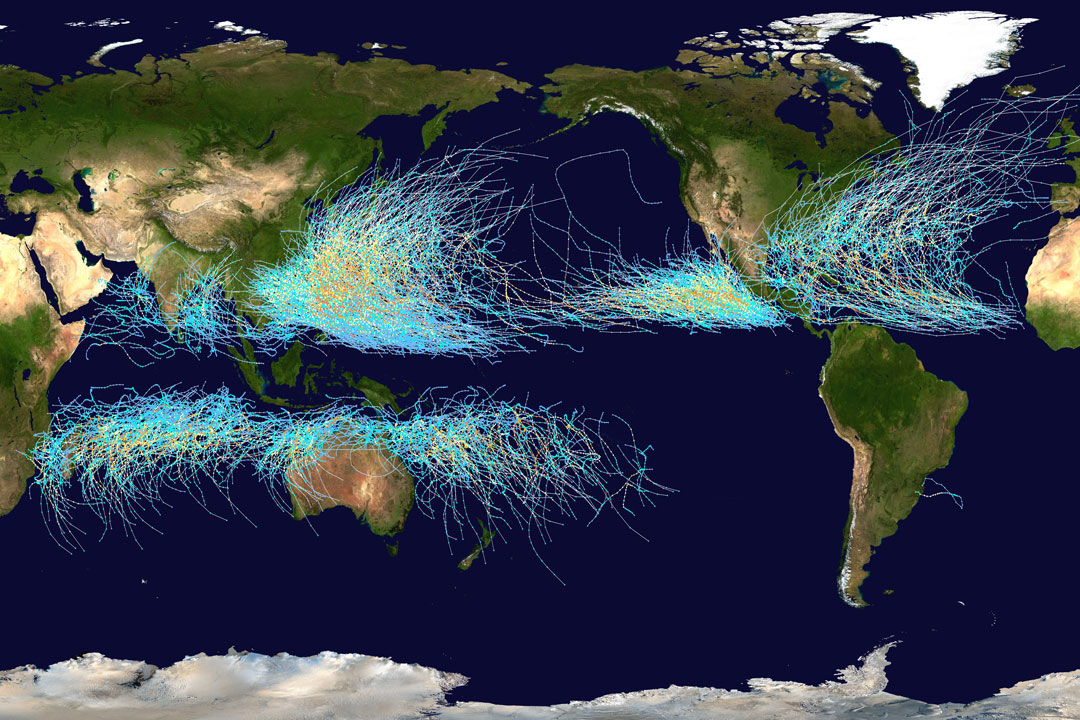15. September 2021
地球面頂 ê 氣旋路線

探索宇宙1!逐工會揀一幅無仝款 ê 影像抑是相片,𤆬你熟似咱這个迷人 ê 宇宙,閣有專業天文學者2為你3解說4。
- 原始文章:Cyclone Paths on Planet Earth
- 影像來源:National Hurricane Center, NOAA, NASA; 資料處理:Nilfanion (via Wikipedia)
- APOD 嘛有 Instagram:English, Farsi, Indonesian, Persian, kah Portuguese
- 台文翻譯:An-Li Tsai (NCU)
[漢羅] 地球面頂 ê 氣旋路線
地球面頂 ê 氣旋是攏按怎 leh 行? 氣旋 tī 大西洋叫做 颶風,tī 太平洋叫做風颱。 這幅圖 是 ùi 1985 年 到 2005 年 所有主要 ê 風暴路線。 地圖展示 氣旋 通常 tī 海面出現,這是合理 ê,因為溫暖 ê 海水蒸發了後會予 in 能量。 Ùi 地圖閣看會著氣旋袂 kah 地球赤道 交叉,嘛真少倚近赤道。 因為 科氏效應 tī 赤道 ê 作用是零,氣旋愛有科氏力才有法度循環。 科氏力 嘛造成 氣旋 照弧形路線走離赤道。 這款長期趨勢嘛是一个 研究主題。 有證據表示,平均來講,颶風 tī 過去 30 冬 tī 北大西洋 變甲 閣較強矣,而且 in ê 強度 看起來是會愈來愈強。
[POJ] Tē-kiû bīn-téng ê Khì-soân lō͘-sòaⁿ
Tē-kiû bīn-téng ê khì-soân sī lóng án-chóaⁿ leh kiâⁿ? Khì-soân tī Tāi-se-iûⁿ kiò-chò kū-hong, tī Thài-pêng-iûⁿ kiò-chò hong-thai. Chit-pak-tô͘ sī ùi i̍t-kiú-pat-ngó͘ nî kàu jī-khòng-khòng-ngó͘ nî só͘-ū chú-iàu ê hong-pō lō͘-sòaⁿ. Tē-tô͘ tiān-sī khì-soân thong-siông tī hái-bīn chhut-hiān, che sī ha̍p-lí ê, in-ūi un-loán ê hái-chúi cheng-hoat liáu-āu ē hō͘ in lêng-liōng. Ùi tē-tô͘ koh khòaⁿ-ē-tio̍h khì-soân bōe kah Tē-kiû chhek-tō kau-chhe, mā chin-chió óa-kīn chhek-tō. In-ūi Kho-sī-hāu-èng tī chhek-tō ê chok-iōng sī lêng, khì-soân ài ū Kho-sī-le̍k chiah ū-hoat-tō͘ sûn-khoân. Kho-sī-le̍k mā chō-sêng khì-soân chiàu hô͘-hêng lō͘-sòaⁿ chàu-lî chhek-tō. Chit-khoán tn̂g-kî chhu-sè mā-sī chi̍t-ê gián-kiù chú-tê. Ū chèng-kù piáu-sī, pêng-kun lâi-kóng, kū-hong tī kòe-khì saⁿ-cha̍p tang tī Pak-tāi-se-iûⁿ piàn-kah koh-khah kiông ah, jî-chhiáⁿ in ê kiông-tō͘ khòaⁿ--khí-lâi sī ē lú-lâi-lú-kiông.
[KIP] Tē-kiû bīn-tíng ê Khì-suân lōo-suànn
Tē-kiû bīn-tíng ê khì-suân sī lóng án-tsuánn leh kiânn? Khì-suân tī Tāi-se-iûnn kiò-tsò kū-hong, tī Thài-pîng-iûnn kiò-tsò hong-thai. Tsit-pak-tôo sī uì i̍t-kiú-pat-ngóo nî kàu jī-khòng-khòng-ngóo nî sóo-ū tsú-iàu ê hong-pō lōo-suànn. Tē-tôo tiān-sī khì-suân thong-siông tī hái-bīn tshut-hiān, tse sī ha̍p-lí ê, in-uī un-luán ê hái-tsuí tsing-huat liáu-āu ē hōo in lîng-liōng. Uì tē-tôo koh khuànn-ē-tio̍h khì-suân buē kah Tē-kiû tshik-tō kau-tshe, mā tsin-tsió uá-kīn tshik-tō. In-uī Kho-sī-hāu-ìng tī tshik-tō ê tsok-iōng sī lîng, khì-suân ài ū Kho-sī-li̍k tsiah ū-huat-tōo sûn-khuân. Kho-sī-li̍k mā tsō-sîng khì-suân tsiàu hôo-hîng lōo-suànn tsàu-lî tshik-tō. Tsit-khuán tn̂g-kî tshu-sè mā-sī tsi̍t-ê gián-kiù tsú-tê. Ū tsìng-kù piáu-sī, pîng-kun lâi-kóng, kū-hong tī kuè-khì sann-tsa̍p tang tī Pak-tāi-se-iûnn piàn-kah koh-khah kiông ah, jî-tshiánn in ê kiông-tōo khuànn-khí-lâi sī ē lú-lâi-lú-kiông.
[English] Cyclone Paths on Planet Earth
Where on Earth do cyclones go? Known as hurricanes when in the Atlantic Ocean and typhoons when in the Pacific, the featured map shows the path of all major storms from 1985 through 2005. The map shows graphically that cyclones usually occur over water, which makes sense since evaporating warm water gives them energy. The map also shows that cyclones never cross -- and rarely approach -- the Earth's equator, since the Coriolis effect goes to zero there, and cyclones need the Coriolis force to circulate. The Coriolis force also causes cyclone paths to arc away from the equator. Although long-term trends remain a topic of research, evidence indicates that hurricanes have become, on the average, more powerful in the North Atlantic over the past 30 years, and their power is projected to keep increasing.
詞彙學習
| 漢羅 | POJ | KIP | 華語 | English |
|---|---|---|---|---|
| 氣旋 | khì-soân | khì-suân | 氣旋 | cyclone |
| 大西洋 | Tāi-se-iûⁿ | Tāi-se-iûnn | 大西洋 | the Atlantic Ocean |
| 太平洋 | Thài-pêng-iûⁿ | Thài-pîng-iûnn | 太平洋 | the Pacific Ocean |
| 颶風 | kū-hong | kū-hong | 颶風 | hurricane |
| 赤道 | chhek-tō | tshik-tō | 赤道 | equator |
| 交叉 | kau-chhe | kau-tshe | 交叉 | cross |
| 科氏效應 | Kho-sī-hāu-èng | Kho-sī-hāu-ìng | 科氏效應 | Coriolis effect |
| 科氏力 | Kho-sī-le̍k | Kho-sī-li̍k | 科氏力 | Coriolis force |
| 循環 | sûn-khoân | sûn-khuân | 循環 | circulate |